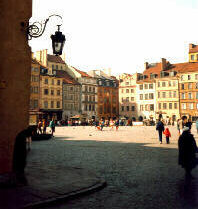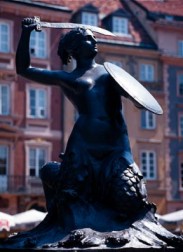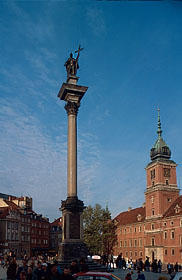 Warsaw has two historic districts, called Old Town and New Town. They are adjacent to each other and the newer section is almost as old as the Old Town. The Old Town, called Stare Miasto in Polish, was completely destroyed in World War II but, like Nürnberg, some of it has been rebuilt to look like the original. Without a guide to tell you these things, one would never guess that the market square in Old Town Warsaw is a complete reconstruction. This market square, known as a Rynek in Polish, was thriving way back in the 13th century.
Warsaw has two historic districts, called Old Town and New Town. They are adjacent to each other and the newer section is almost as old as the Old Town. The Old Town, called Stare Miasto in Polish, was completely destroyed in World War II but, like Nürnberg, some of it has been rebuilt to look like the original. Without a guide to tell you these things, one would never guess that the market square in Old Town Warsaw is a complete reconstruction. This market square, known as a Rynek in Polish, was thriving way back in the 13th century.
Warsaw is bisected by the River Vistula and it is the left bank that is of interest to visitors.  On the other side of the river is a residential area which is a depressing sight. The whole city of Warsaw is built on completely level terrain, except that Old Town is a few feet lower, so it is like stepping down into another room in a split level house when you enter the historic district. After the German bombing of Warsaw destroyed the city in World War II, the main part of the city was rebuilt with modern buildings constructed on top of the rubble. Only the Old Town was cleared and the buildings reconstructed, which accounts for the split level effect. On the other side of the river is a residential area which is a depressing sight. The whole city of Warsaw is built on completely level terrain, except that Old Town is a few feet lower, so it is like stepping down into another room in a split level house when you enter the historic district. After the German bombing of Warsaw destroyed the city in World War II, the main part of the city was rebuilt with modern buildings constructed on top of the rubble. Only the Old Town was cleared and the buildings reconstructed, which accounts for the split level effect.  The entrance to Old Town is marked by a 72-foot high Corinthian column on top of which is a bronze statue of King Zygmunt Waza, the monarch who was responsible for moving the capital of Poland from Krakow to Warsaw in 1596, after Poland and Lithuania united into one country. When it was erected in 1633, this column was the most grandiose monument to be placed in Europe since the fall of the Roman Empire. The statue was designed by Italian sculptor Clemente Molli and King Zygmunt Waza was born in Sweden. Poland was actually the first multicultural country, not America.
The picture below shows the monument, which is in plac Zamkowy, a large market square that is now filled with restaurant tables with umbrellas advertising Frito Lay. The picture below it shows what this square looked like after the destruction of World War II. Almost 90% of Old Town Warsaw was demolished and the reconstruction project lasted from 1949 to 1963. The Royal Palace is in the plaza to the east of where the column stands; it was surrounded by scaffolding while reconstruction was still going on when I was there in Sept. 1998. The palace was destroyed by bombing in 1944 and rebuilding did not begin until 1971.
The entrance to Old Town is marked by a 72-foot high Corinthian column on top of which is a bronze statue of King Zygmunt Waza, the monarch who was responsible for moving the capital of Poland from Krakow to Warsaw in 1596, after Poland and Lithuania united into one country. When it was erected in 1633, this column was the most grandiose monument to be placed in Europe since the fall of the Roman Empire. The statue was designed by Italian sculptor Clemente Molli and King Zygmunt Waza was born in Sweden. Poland was actually the first multicultural country, not America.
The picture below shows the monument, which is in plac Zamkowy, a large market square that is now filled with restaurant tables with umbrellas advertising Frito Lay. The picture below it shows what this square looked like after the destruction of World War II. Almost 90% of Old Town Warsaw was demolished and the reconstruction project lasted from 1949 to 1963. The Royal Palace is in the plaza to the east of where the column stands; it was surrounded by scaffolding while reconstruction was still going on when I was there in Sept. 1998. The palace was destroyed by bombing in 1944 and rebuilding did not begin until 1971.
|




 Warsaw has two historic districts, called Old Town and New Town. They are adjacent to each other and the newer section is almost as old as the Old Town. The Old Town, called Stare Miasto in Polish, was completely destroyed in World War II but, like Nürnberg, some of it has been rebuilt to look like the original. Without a guide to tell you these things, one would never guess that the market square in Old Town Warsaw is a complete reconstruction. This market square, known as a Rynek in Polish, was thriving way back in the 13th century.
Warsaw has two historic districts, called Old Town and New Town. They are adjacent to each other and the newer section is almost as old as the Old Town. The Old Town, called Stare Miasto in Polish, was completely destroyed in World War II but, like Nürnberg, some of it has been rebuilt to look like the original. Without a guide to tell you these things, one would never guess that the market square in Old Town Warsaw is a complete reconstruction. This market square, known as a Rynek in Polish, was thriving way back in the 13th century.
 On the other side of the river is a residential area which is a depressing sight. The whole city of Warsaw is built on completely level terrain, except that Old Town is a few feet lower, so it is like stepping down into another room in a split level house when you enter the historic district. After the German bombing of Warsaw destroyed the city in World War II, the main part of the city was rebuilt with modern buildings constructed on top of the rubble. Only the Old Town was cleared and the buildings reconstructed, which accounts for the split level effect.
On the other side of the river is a residential area which is a depressing sight. The whole city of Warsaw is built on completely level terrain, except that Old Town is a few feet lower, so it is like stepping down into another room in a split level house when you enter the historic district. After the German bombing of Warsaw destroyed the city in World War II, the main part of the city was rebuilt with modern buildings constructed on top of the rubble. Only the Old Town was cleared and the buildings reconstructed, which accounts for the split level effect.  The entrance to Old Town is marked by a 72-foot high Corinthian column on top of which is a bronze statue of King Zygmunt Waza, the monarch who was responsible for moving the capital of Poland from Krakow to Warsaw in 1596, after Poland and Lithuania united into one country. When it was erected in 1633, this column was the most grandiose monument to be placed in Europe since the fall of the Roman Empire. The statue was designed by Italian sculptor Clemente Molli and King Zygmunt Waza was born in Sweden. Poland was actually the first multicultural country, not America.
The picture below shows the monument, which is in plac Zamkowy, a large market square that is now filled with restaurant tables with umbrellas advertising Frito Lay. The picture below it shows what this square looked like after the destruction of World War II. Almost 90% of Old Town Warsaw was demolished and the reconstruction project lasted from 1949 to 1963. The Royal Palace is in the plaza to the east of where the column stands; it was surrounded by scaffolding while reconstruction was still going on when I was there in Sept. 1998. The palace was destroyed by bombing in 1944 and rebuilding did not begin until 1971.
The entrance to Old Town is marked by a 72-foot high Corinthian column on top of which is a bronze statue of King Zygmunt Waza, the monarch who was responsible for moving the capital of Poland from Krakow to Warsaw in 1596, after Poland and Lithuania united into one country. When it was erected in 1633, this column was the most grandiose monument to be placed in Europe since the fall of the Roman Empire. The statue was designed by Italian sculptor Clemente Molli and King Zygmunt Waza was born in Sweden. Poland was actually the first multicultural country, not America.
The picture below shows the monument, which is in plac Zamkowy, a large market square that is now filled with restaurant tables with umbrellas advertising Frito Lay. The picture below it shows what this square looked like after the destruction of World War II. Almost 90% of Old Town Warsaw was demolished and the reconstruction project lasted from 1949 to 1963. The Royal Palace is in the plaza to the east of where the column stands; it was surrounded by scaffolding while reconstruction was still going on when I was there in Sept. 1998. The palace was destroyed by bombing in 1944 and rebuilding did not begin until 1971.

